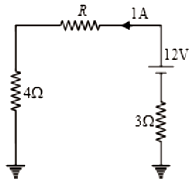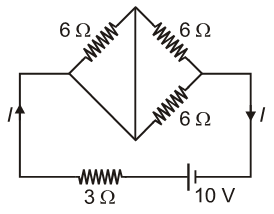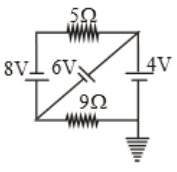The equivalent resistance between points \(A\) and \(B\) in the circuit shown in the figure is:

1.
\(6R\)
2.
\(4R\)
3.
\(2R\)
4.
\(R\)
In the circuit shown in the figure, the effective resistance between A and B is:

1. 2
2. 4
3. 6
4. 8
For the circuit shown in the figure, the value of R must be

1. 3
2. 4
3. 5
4. 6
Current I as shown in the circuit will be

1. 10 A
2.
3.
4.
The current through the 5 resistor is

(1) 3.2A
(2) 2.8A
(3) 0.8A
(4) 0.2A
In the figure, a carbon resistor has bands of different colours on its body as mentioned in the figure. The value of the resistance is:
1. \(2.2\) k\(\Omega\)
2. \(3.3\) k\(\Omega\)
3. \(5.6\) k\(\Omega\)
4. \(9.1\) k\(\Omega\)
A copper wire has a square cross-section, 2.0 mm on a side. It carries a current of 8 A and the density of free electrons is 8 × 1028 m–3. The drift speed of electrons is equal to
(1) 0.156 × 10–3 m.s–1
(2) 0.156 × 10–2 m.s–1
(3) 3.12 × 10–3 m.s–1
(4) 3.12 × 10–2 m.s–1
The equivalent resistance of the following infinite network of resistances is
(1) Less than 4 Ω
(2) 4 Ω
(3) More than 4 Ω but less than 12 Ω
(4) 12 Ω
What is the current (i) in the circuit as shown in figure
(1) 2 A
(2) 1.2 A
(3) 1 A
(4) 0.5 A
In the given figure, the equivalent resistance between the points A and B is :
(1) 8 Ω
(2) 6 Ω
(3) 4 Ω
(4) 2 Ω










